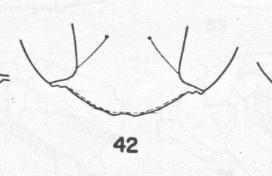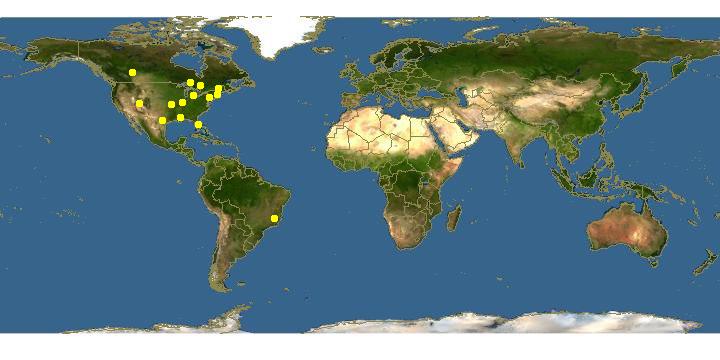
Arnold S. E. Menke, 1965 · 1
Ammophila harti, female, clypeus |

Click on map for details about points.
|
|
Overview |
Taken from: A Revision of the North American Ammophila (hymenoptera, Sphecidae). Arnold S. E. Menke, 1965.
Ammophila (Ammophila) harti (Fernald)
(Figs. 42, 62)
Ammophila argentata Hart, 1907. Bull. Illinois St. Lab. Natur. Hist. 7:266.
Lectotype female, Topeka, Illinois (Illinois State Natural History Survey, Urbana), designated by Frison, 1927.
Sphex harti Fernald, 1931. Ann. Entomol. Soc. Amer. 24:450.
New name for Sphex argentata (Hart), preoccupied by Sphex argentata Fabricius, 1787.
The metapleural flange (fig. 62) and yellowish wing veins are distinctive in harti. The clypeal teeth are usually poorly developed or lacking in female harti (fig. 42). This species is probably most closely allied with azteca but the yellowish wing veins are diagnostic.
I have not seen the type of harti but a homotype made by H. T. Fernald has been studied.
Ammophila harti occurs from Texas to Alberta and eastward through the northern states and southern Canada to Vermont and Quebec. Sand dune areas seem to be the favored habitat.
Ammophila azteca Group
Diagnosis. The azteca group characteristics are essentially the same as for the urnaria group except that the preepisternal sulcus is long, ending in the ventral region.
Included species. Ammophila acuta (Fernald), azteca Cameron, breviceps Smith, californica Menke, evansi Menke, harti (Fernald), karenae Menke, mediata Cresson, peckhami (Fernald), pruinosa Cresson, regina Menke, strenua Cresson and varipes Cresson.
Discussion. The azteca group is in need of a thorough study since the status of several species is in doubt, For example, “Ammophila pruinosa” is now known to consist of several closely related and undescribed species. The same situation may exist in Ammophila strenua and azteca.
Erect hair color, mesopleural patterns of appressed silver hair, color, and the configuration of the pronotal collar are useful for species discrimination in this group, The male genitalia are distinct in only half of the species; e, g., acute, californica, karenae, peckhami, pruinosa and regina (see figs, 115-120). The aedeagi of the remaining species are similar to that of Ammophila urnaria in the urnaria group (figs. 128-129).
The azteca group is represented throughout North America, The range of A. mediate and azteca extends past the Arctic Circle in western Canada. The group occurs in Mexico and specimens of an undescribed species belonging to the azteca group have been seen from the Andes of South America.
|
|
|
Names | |
|
|
| Supported by | |
Updated: 2024-04-26 16:00:16 gmt
|